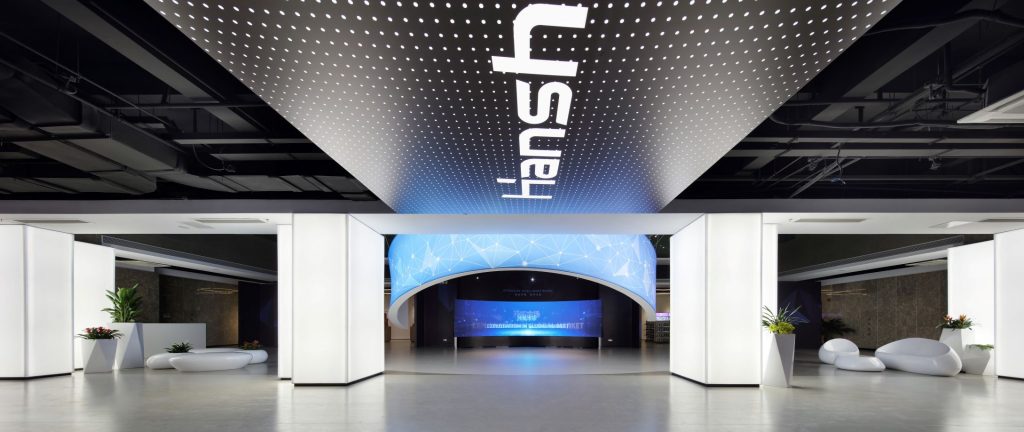
Hanshow accelerates brick-and-mortar retail innovation through its work with Microsoft
Hanshow is a world-leading provider of in-store IoT devices in the form of electronic shelf labels (ESLs), digital shelf display and smart shopping carts. Hanshow offers comprehensive digital solutions to leading brick-and-mortar stores and brands globally. Although the company is headquartered in China, roughly 70% of its sales are generated from overseas.
Hanshow is expanding its offerings on Microsoft Azure and did a 2-week engagement with Microsoft AI & IoT Insider Lab in Shanghai in 2020 to use Microsoft technologies to develop in-store consumer behavior analysis and generate interactive content on their digital signage based on this information. The engagement laid the foundation for their commercialization of the next-generation solutions.
Hanshow augmented its existing ESL solutions through artificial intelligence (AI)-integrated capabilities to provide consumer behavior analysis, inventory management and other digital functions that are increasingly attractive to retailers and its customers.
Through the lab engagement, I came to know Jennifer Guan, vice president for strategy and partnerships at Hanshow. She worked as a managing director at Oaklins China before joining Hanshow and has 10-plus years of experience in corporate finance and cross-border mergers and acquisitions. It was a pleasure to interview her and hear her insights on retail technologies. The interview has been lightly edited for clarity.
ZHU: Thank you, Jennifer, for taking the time. Could you give a brief introduction of Hanshow’s products and solutions?
GUAN: Hanshow is a company at the forefront of helping retail stores adopt digital solutions. The retail industry is seeing rapid transformation, not just from how e-commerce is changing the game, but from the rapid adoption of digital transformation within brick-and-mortar stores as well.
We offer a wide range of IoT intelligent devices such as ESLs, smart trolley, self-service kiosks, as well as cloud-based SaaS solutions to global retailers. Our digital marketing and digital shelf solution provide targeted and customized promotions to customers using smart trolleys and in-store screens to facilitate retailers and FMCG companies to know their customers, empower employees and enable intelligent supply chains.
ZHU: Given your experience of dealing with overseas customers, both before and at Hanshow, I’m sure you have had different experiences between China and overseas markets. Based on these differences, how are Hanshow’s strategies different across regions? Which market is growing the fastest?
GUAN: There are certainly differences in the Chinese and international markets, but at the end of the day, retailers all face very similar challenges in how to adapt and thrive in the digital age. Our solutions are gaining traction both here in China and overseas. In fact, our biggest market growth has been from Europe and APAC countries. In fact, Japan is now a larger part of our business than China.
Our cutting-edge solutions, highly reliable products and quality of services speak for themselves, and they are the reason I think we’ve been successful regardless of geographical locations.
In general terms, Western retailers tend to prefer more sophisticated solutions that focus on sustainability, operation efficiency and TCO (total cost of ownership) reduction. European customers prefer IoT devices managed on a centralized SaaS platform, helping them to save cost of management for those devices. We have recently achieved deploying 10 million units of ESLs on Azure to a single client, a leading European retailer.
In the Chinese market, more retailers are focused on driving new revenue from attracting more customers through more modern displays and experiences that would create a “cool” factor. Rental expense accounts for the majority of total costs, therefore driving up sales per square feet, is the key concern for Chinese retailers.

Angie Zhu and Jennifer Guan. (Courtesy of Jennifer Guan)
ZHU: Hanshow experienced rapid growth in 2020 and became a leading supplier of ESLs in terms of units shipped globally. I would have expected the adoption to be slower at brick-and-mortar stores during the pandemic. How did Hanshow manage to gain such growth despite the pandemic?
GUAN: Retail, like many other industries, struggled during the pandemic. Many retailers turned to strengthen their online channels and adopt new online marketing methods, like selling through mini programs on social platforms and engaging in live broadcasting. Some retailers also began to adapt new AI and IoT technologies to explore unmanned retail business models and contactless delivery.
It is true that the retailers who were quicker to adapt new technologies outperformed their peers. For our solutions, we address a number of challenges for customers from a different angle for traditional retailers to save costs and increase efficiencies during difficult times. Efficiency enhancements, such as staffing surges during peak hours, labor costs, space constraints and better productivity management for hundreds of stores across regions, were important for these established retailers.
To realize cloud-based management on the scale of our customers’ international operations, Hanshow partnered with Microsoft IoT technology to develop a SaaS solution that can handle this massive amount of integration. Hanshow’s operating system was tailored to run on Azure SQL PaaS, unlocking the full potential of cloud-based management. With Microsoft’s established and industry-leading Azure service already in place, retailers could now operate their new digital ESL systems and other in-store digital solutions over the cloud instantly.
Other than providing reliable and cost-efficient products to our customers, I believe the partnership with Microsoft to create an easy-to-integrate system over the cloud also contributed to the success that we experienced last year.
ZHU: Let’s talk about the different approaches to digital transformation in the offline retail space. It seems to me that you are offering your client a more gradual, step-by-step digital transformation solution, compared to the fully automated solution like Amazon Go. What are the advantages of your approach?
GUAN: Hanshow’s approach is focused on solving traditional retailer client needs, so providing value to these long-established retailers is our top priority. A more gradual digital transformation approach has, so far, proven to be what most retailers see as the most beneficial to their operations. Keep in mind that these retailers are long-established companies that operate networks of hundreds or thousands of stores. They need a step-by-step approach to updating their operations to see what works best along the way and build on that, like putting pieces of the puzzle together.
Fully autonomous models like Amazon Go are starting from scratch and mostly at small scales. Full autonomy solutions would be massive investments for established retailers, while our step-by-step approach offers visible benefits in a shorter period of time, which is more practical and cost-effective. We believe that a more gradual approach enables retailers to realize their digital strategy in a more systematic and reliable way. Using services like SaaS already significantly increases autonomy, allowing for remote and instant management of millions of ESLs across hundreds of stores. A step taken that instantly increased efficiency for our customers for a fraction of the investment.

Hanshow’s Jiaxing, China office. (Courtesy of Hanshow)
ZHU: How do you plan to “upgrade” the services for your existing customers in the future? What is the next step to digital transformation? What are your plans to further work with MSFT in the retail space?
GUAN: The next step involves increasing IoT connectivity, more AI functionality and continued improvements to back-end systems that can open up more possibilities. We’re still in the early stages of using AI in digital retail technology and I believe that there is so much more that can be done once the infrastructure is in place.
These digital marketing solutions and what we call “smart store solutions” are increasingly a core part of Hanshow’s business. This is also one of the most important areas that we hope to co-innovate with Microsoft’s IoT and Edge team. Several co-innovation projects are in process in Microsoft’s AI & IoT Lab in China, and we are expecting more in-depth collaboration with Microsoft’s product and R&D teams. At the same time, the more behind-the-scenes solutions such as partnering with Microsoft on SaaS are also significant upgrades for our clients, and I think will quickly become the norm for installing digital solutions.
Microsoft has always been our top choice for a strategic collaboration with the synergy in many areas of retail digital transformation globally, and I’m thrilled to see the early results to be better than what we expected. I believe that Hanshow and Microsoft share the same value in using technology to provide solutions that can change the world to be more efficient and sustainable.
Similar to how using cloud-based solution is more lightweight than companies building their own infrastructure and networks, stores adopting ESL and other digital solutions also greatly reduce paper and plastic waste in stores. A single ESL has a battery life up to 15 years. Think about how much trash a store produces over 15 years just on pricing and promotion with printed paper and plastic labels. ESL also allows for dynamic pricing, which by promoting soon-to-expire food items has been shown to significantly reduce waste. These sustainability impacts are heightened when our companies combine forces.
ZHU: Lastly, as a female executive originally coming from a finance background, why did you decide to join A retail technology startup like Hanshow? What advice would you give to other women in technology?
GUAN: Hanshow is an exciting, innovative, and fast-moving company that offers me new challenges and opportunities every day. I honestly can’t say the same about the finance industry. I’ve experienced so much professional and personal growth since joining this company.
I’ve never felt restrained as a woman in technology or finance; I’ve always just plowed ahead. I am working in a position that aligns with my interests and skills and that is where I have to push myself. I believe any woman with an interest and skillset for technology can chart her own path here. With confidence, hard work and an open mind, your possibilities are boundless.
Top photo: A Hanshow customer scans an electronic shelf label with a mobile phone to get detailed product information. (Courtesy of Hanshow)
